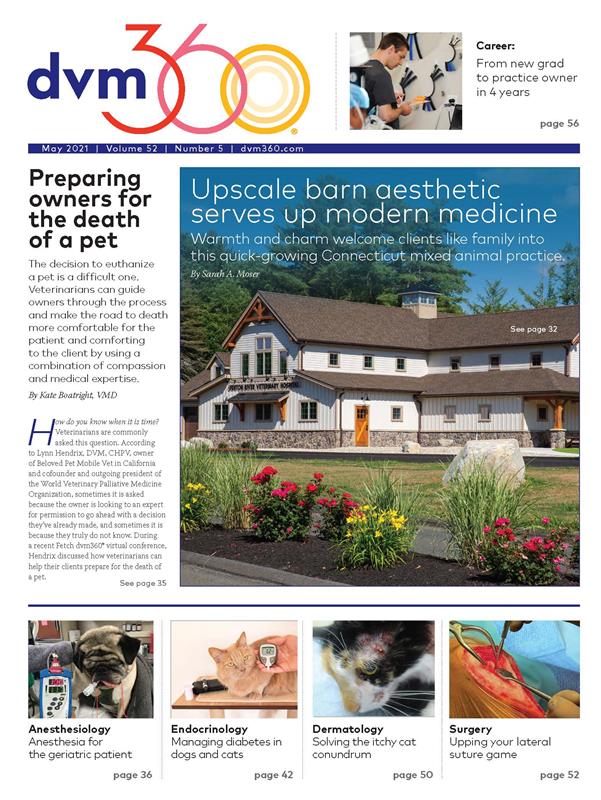Setting, monitoring, and achieving KPIs in veterinary practice
Achieving success with key performance indicators starts with promoting a vision, mission, and purpose that each of your staff members can believe in.
There was very little precedent veterinary business leaders could draw from when COVID-19 hit last year. Our practices, playbooks, and continuity plans were put to the test as patient loads rapidly increased and demands for staff and supplies swelled. This force had much to do with the uptick in pet ownership and the global shift to telework.
With dogs and cats now by their owners’ sides 24/7, pet owners have become increasingly attuned to signs of pet illness or injury.1 This strengthening of the human-animal bond, coupled with pandemic-related clinic closures or limited clinic hours, has led to a population-wide backlog in vaccines, spays and neuters, and routine wellness exams. To accommodate this backlog as well as patient overflow, hospitals have instituted technological optimizations and transformed the ways in which they care for people and their pets.
In a time of widespread crisis, we as veterinary leaders asked ourselves: How do we continue to keep our essential workers safe and engaged while still providing necessary, high-quality care to thousands of pets each day? To seize this new landscape, business performance plans pivoted, with leaders taking a more holistic approach to meeting both their fiscal needs and the needs of their people.
Starting with your why
In his book Start With Why: How Great Leaders Inspire Everyone to Take Action, Simon Sinek argues that inspiration is among the main ways to influence human behavior and that leadership alone holds the key to inspiring people to come together to advance a common interest.2 Throughout the book, Sinek states, “People don’t buy what you do; they buy why you do it.”
Before setting your practice’s goals, objectives, and key performance indicators (KPIs), ask yourself: Why did you pursue a career in veterinary medicine? Why do you continue to get out of bed each morning and, despite deep exhaustion, take on those extra shifts? The responses to these questions are your purpose(s), your deeply ingrained beliefs that compel you to do the work you do despite personal sacrifice. However, as powerful as purpose is, it is often lost in the whirlwind of our daily tasks.
To find success, help your people see their impact—on people, pets, or the world—and develop a story line that will resonate and remind them of their why (the reason they love what they do). To do this, you must take an individual approach that aims to evoke an emotional reaction.3 Remember that purpose is personal; it needs not only to be understood, but also to be felt and embraced. Lead by example. If you do not believe in what you are saying or your leadership behaviors do not align with your purpose, team members will view your efforts as deceitful rather than inspirational. Finally, make sure your actions are continual and consistent. Highlighting staff achievements, sharing patient success stories, and showcasing client testimonials all allow employees to witness the impact of their jobs firsthand and are powerful tools that inspire them to bring their best selves to work.
Even though most leaders agree that employees do not understand their organizations’ purpose, when articulated and integrated properly, purpose can do wonders to boost employee morale and performance.
There is a well-known story that during a trip to NASA headquarters in 1962, President John F. Kennedy introduced himself to a janitor and asked the man what he did there. “I’m helping put a man on the moon,” the janitor responded. Although most people would say this man was merely cleaning the building, the janitor knew he was part of something larger, that he was helping make history. This is the power of an embraced purpose.
Before getting to the “how” and “what,” ask yourself: Can my hospital team clearly state the vision, mission, and purpose of the company? Can leadership? Does our purpose inspire both hearts and minds? If the answer to these questions is yes, you will have a business performance plan that is better received and accepted. However, if your hospital team cannot see how they fit into the larger picture, then it is up to leadership to paint that picture for them.
Setting KPIs and defining success
Forward-thinking and innovative veterinary businesses take a full-circle approach, which often includes a mutual emphasis on excellence in people, operations, and medicine. Although growth and expansion are also important concepts for structuring your objectives and KPIs, leading medicine with these 3 core concepts has proved to be an optimal method for achieving success.
People excellence is the idea that operational and business performance can be improved by enhancing human capital. To do this, one can invest in compensation and benefits, health and well-being initiatives, or programs focused on personal growth. Programs aimed to enhance individual development (eg, educational/career pathways) are critical components in attaining both people and operational excellence, as technical outcomes often are contingent on people skills. These necessary but often-overlooked skills include leadership, team dynamics, communication, change management, and conflict resolution.
Operational excellence is an ideology that embraces principles and tools that create sustainable improvement within a practice.4 Operational excellence can be achieved when every member of an organization can identify the flow of value from the hospital to the patient and/or client and can proactively identify and improve kinks in the system of care (or operational inefficiencies).
Medical excellence is an idea that medical treatment as well as the practice of veterinary medicine can be drastically improved through principles and programs that shine a light on medical error, support evidence-based medicine and an open communication culture, align with innovative technology and data, and encourage client/caretaker empowerment.5
Within each of these frameworks, define your objectives and KPIs. Objectives, or SMART (specific, measurable, achievable, realistic, and time-bound) goals, are your overarching goals; whereas KPIs are indicators to help evaluate or measure the progress you make during your journey toward achieving the objectives. After your high-level pillars have been defined, establish your strategies: action-oriented items that you will implement to achieve your set objectives.
For example, within the medical excellence framework, one of your company objectives may be to aim for zero patient safety events. The KPI in this example could be the number of patient safety incidents reported. One strategy to achieve your objective could then be to appoint a medical quality team that oversees and improves systems that commonly produce error.
It is important to note that even though you may have achieved your KPI of zero patient safety events, you may have not succeeded. Although your patient safety incidents might have been zero, if your near misses were 40, there are still flaws in the system. In such cases, you likely have an incorrect strategy, objective, or measurement. It is OK to go back to the drawing board, but remember to fail fast. Most innovative companies failed fast yet ultimately succeeded by having a keen ability to adapt to changing environments.
Leading vs lagging KPIs
A well-balanced performance management system has both leading and lagging KPIs (or indicators).6 Leading KPIs are best described as metrics that could help you see into the future, such as client satisfaction or the number of unique new clients, whereas lagging KPIs are metrics that are easy to identify and measure, such as revenue or profit numbers. While lagging KPIs are critical to the livelihood of a company, these indicators generally do not motivate teams.
Let’s look at an example. Say you want to achieve revenue growth of 10% on a comparable basis. In this case, your leading KPI could be the number of patient visits or new/unique clients (as a volume indicator) or the average patient charge (as a price indicator). In the specialty and emergency space, specifically, you may look at the number of primary care veterinarians that refer to you. Lagging KPIs here could be revenue, profit, or labor or material cost per cases seen (output).
Reach people, reach goals
Martin Luther King Jr (MLK), one of the most visible leaders in the American civil rights movement, is a prime example of how a well-articulated purpose can motivate a population and change a culture. MLK took incremental yet intentional steps to make his dream a reality, preaching to millions of Americans about the rights of life, liberty, and the pursuit of happiness. Today, we, as a country, continue to embrace this purpose, not only because it is the right and moral thing to do, but also because it is ingrained within the broader framework of humankind. His why is and continues to be something we all can believe in. The same principle should hold true for your organization's purpose.
Remember: The world we want tomorrow starts with how we do business today. To attain true success, you must reach the minds and hearts of your people and promote a vision, mission, and purpose that each of your staff members can believe in. As you establish your performance measurement systems for the year, think about how these goals will be shared with the broader members of the team. Will they be able to connect the dots? Although their day-to-day tasks may seem insignificant to them, they are how the larger vision comes to life. Make sure they know this.
Nicholas Nelson is chief operating officer at BluePearl Specialty and Emergency Pet Hospital in Tampa, Florida.
References
- Full house: people and pets in the pandemic—BluePearl Pet Hospital’s 2020 Pet Ownership Report. BluePearl Specialty and Emergency Pet Hospital. 2021. Accessed April 12, 2021. https://bluepearlvet.com/wp-content/uploads/2021/02/BluePearl-Pet-Hospitals-2020-Pet-Owner-Report-People-and-Pets-in-the-Pandemic.pdf
- Ranadive A. The power of starting with why. Medium. May 26, 2017. Accessed April 12, 2021. https://medium.com/leadership-motivation-and-impact/the-power-of-starting-with-why-f8e491392ef8
- Cable D. Helping your team feel the purpose in their work. Harvard Business Review. October 22, 2019. Accessed April 12, 2021. https://hbr.org/2019/10/helping-your-team-feel-the-purpose-in-their-work
- Hanna L. What it takes to achieve operational excellence. Kail Nexus. February 12, 2019. Accessed April 12, 2021. https://blog.kainexus.com/improvement-disciplines/operational-excellence/what-it-takes-to-achieve-operational-excellence
- Elrod JK, Fortenberry JL Jr. Centers of excellence in healthcare institutions: what they are and how to assemble them. BMC Health Serv Res. 2017;17(suppl 1):425. doi:10.1186/s12913-017-2340-y
- Cespedes FV, Marsh B. Find the right metrics for your sales team. Harvard Business Review. August 22, 2017. Accessed April 12, 2021.https://hbr.org/2017/08/find-the-right-metrics-for-your-sales-team

